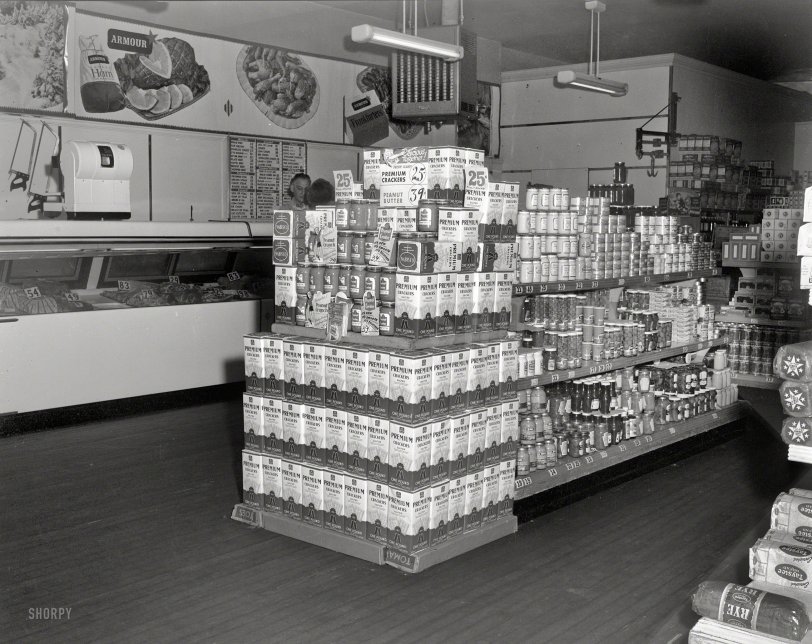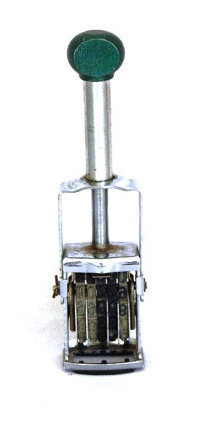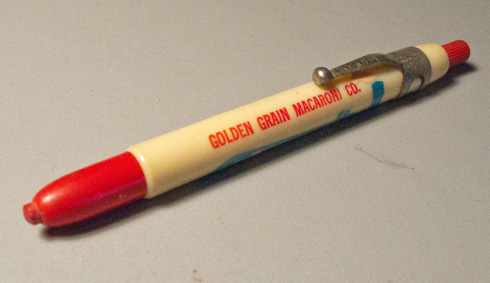


Framed or unframed, desk size to sofa size, printed by us in Arizona and Alabama since 2007. Explore now.
Shorpy is funded by you. Patreon contributors get an ad-free experience.
Learn more.

- Baldwin 62303
- Baldwin VO-1000
- Cold
- No expense spared
- Tough Guys
- Lost in Toyland
- And without gloves
- If I were a blindfolded time traveler
- Smoke Consumer Also Cooks
- Oh that stove!
- Possibly still there?
- What?!?
- $100 Reward
- Freeze Frame
- Texas Flyer wanted
- Just a Year Too Soon
- WWII -- Replacing men with women at the railroad crossing.
- Yes, Icing
- You kids drive me nuts!
- NOT An Easy Job
- I wonder
- Just add window boxes
- Icing Platform?
- Indiana Harbor Belt abides
- Freezing haze
- Corrections (for those who care)
- C&NW at Nelson
- Fallen Flags
- A dangerous job made worse
- Water Stop
Print Emporium
Delicious Together: 1947

New York circa 1947. "Grocery display of Premium crackers and peanut butter." That old Brown Magic! 5x7 acetate negative by John M. Fox. View full size.
Meat Counter
I can remember our local IGA store, about this time, had almost the same items for sale at the meat counter. If you wanted chicken they had dressed chickens on display but if you wanted a fresh chicken, they had live chickens back in the stock room that were tied by their legs hanging upside down on hooks. You could go back and pick out a live chicken that looked good, take it home, wring its neck, dunk it in boiling water, pick all the feathers, eviscerate it, cut it up however you wanted, and cook it. That's the "Old Timey" way my Mom usually did but please give me todays modern practices. I would probably take the chicken home and turn it loose in the backyard and never have chicken for dinner.
Lysol also works
When we used the old Garvey pricers, we used spray cans of Lysol to remove the old prices from items. Took the ink right off. I still have my old Garvey. The number bands are so brittle that they're falling apart, though.
Stamper sticks
When I worked at a grocery, we had boxes of pen-shaped rubber stamps that marked little circles with a price in it, sometimes something like "3/55" denoting "3 for 55 cents".
I'd have to wipe the alcohol based blue ink off with a solvent-dampened rag and ink the stamp with an ink pad to mark the price on each can. In the process, fingers and clothing invariably got dyed blue.
I recall a minor outcry from shoppers when UPC barcodes first took over because people didn't like NOT having the price marked on the product at the checkout line.
Garvey Flip Pricing Gun
At least, that's what they were called in my days in the grocery business. The mechanism with the numbers would flip when pressed onto a can, so the marking portion would travel to mark the can and be inked on a felt pad on its return. These flip guns were generally carried in a black-leather side holster or kept in the bin of the rolling "float" used to take cases of merchandise from the stock room to the sales floor. All this was pre-scanning days, of course; late 1960s to early 1980s.
Early on Thursday morning, when prices usually changed, the stockmen would go up and down their aisles with a plastic bottle of an ammonia solution, to remove the old prices and restamp the cans with the new prices. Ammonia dissolved the purple ink used with the flip guns and the old ink could be wiped off rather neatly.

Peanut cream.
I'm surprised no one has mentioned the Peanut Cream and Peanut Crunch. Was this term used by one specific manufacturer? I thought it was always Peanut Butter, although Peanut Cream makes sense.
Saltines cited
The OED spies the first use of "Saltine" in a 1907 publication called Grocery World.
Tip-Top & Taystee bread
They probably have Silvercup & Bond also. Fresh Bond bread: you could discard the crust, roll the rest of the slice up in a ball & caulk a boat with it.
Price Stampers
In the early to mid 50s I would go with my father for the regular Saturday morning trip to the grocery. I can remember seeing the folks stocking the shelves using a re-inking stamp to apply the price directly to the top of a can or other container before they removed it from the shipping box. I can still hear the sound of that pricing stamper.
When we got to the checkout I would help unload the cart onto the flat area for the cashier (now a rubber belt). My father would always remind me to place the items with the stamped price facing up to help the cashier.
With the present day scanners it is probably better if the bar code is facing down.
Word not yet invented?
I took me a while to figure out what was strange about this photo. Finally I realized that the word "Saltines" is nowhere to be found. They're simply Premium Crackers, Salted. This was taken the year I was born and I can't remember when they weren't called Saltines.
No Eyestrain!
Prices are prominently posted for cost conscious customers pinching pennies, who today would need a magnifying glass to read the small print on price labels!
[Labels on grocery store products in those days generally did not have printed prices. Store clerks would apply them to the items individually with grease pens, like this one of my father's from the 1940s. -tterrace]
[Modern grocery price labels do not use "small print." -Dave]
Ahem! I did not mention that prices were printed in those days. Look closely at the edges of the shelves under each displayed item. What do you see? Today many items have a small sticker that reflects the price on the aforesaid edges and unless you are two feet tall and/or have a magnifying glass you will not be able to read it easily.

























On Shorpy:
Today’s Top 5